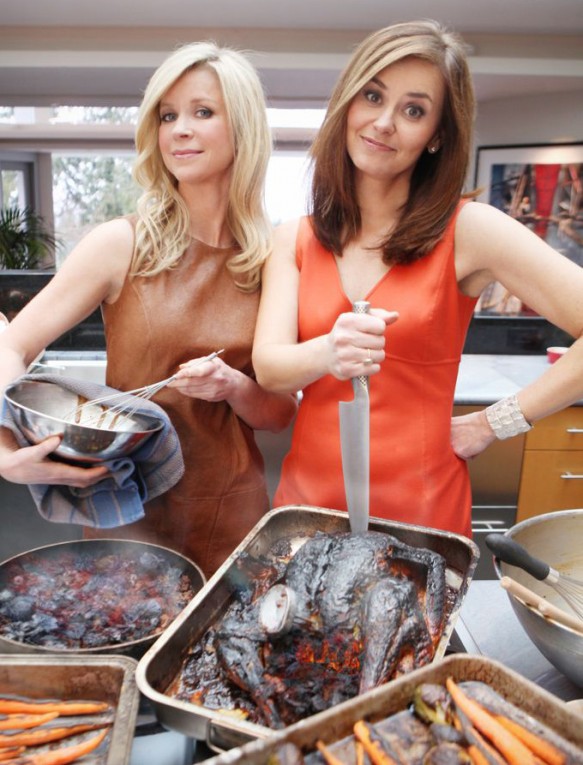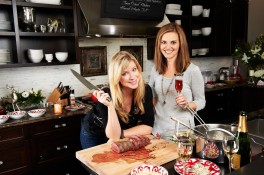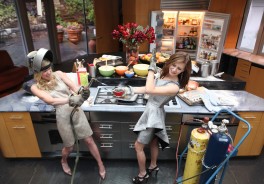
Bra Fitting Tips
Bra shopping can be frustrating if you donít know what to look for or how to fit yourself properly. In fact, almost 8 out of 10 women wear the wrong size! We find out the ins and outs of padding, support, underwire, band size, and cup size.
The Basics
-
With so many styles and choices available these days, you never have to resort to boring beige, unless you want the “nude” look.
-
Bra designs imported from France and Belgium have an excellent track record because of the high quality of fabric and lace used. They cost more, but they will fit well and last a long time.
-
Cup sizes range from AA to JJ, and band measurements from 30-56.
-
Cup styles are plentiful, including:
-
Full cup, which provides the most coverage. It falls anywhere above the topmost swell of the breast and covers the centre front.
-
Demi cup usually means it rises about one inch above the nipple or bust point in coverage and has a much shallower underwire than the full cup. This design pushes the breast toward the centre, allowing for more cleavage and less tissue near the underarm.
-
Baseball cup is made with one seam running across (rather than down) through the bust point (nipple) line and curving from a point near the centre and to somewhere toward the side seam. This creates a vaguely baseball-seam curve in the lower cup piece.
-
Tulip cup is a demi cup cut on a diagonal about one inch from the bust point. The shape is as if the tips of the petals of a tulip are leaning toward the armpit.
-
Contour cup is a lightly padded cup for sizes C and less.
-
-
Aside from the standard “half-H” strap style, you can also choose from:
-
A bandeau: a strapless band around the bust-line made of knit fabric, similar to a 70’s tube top. The wearer is at the mercy of the bra’s fit and ability to remain in place.
-
Convertible straps: can be adjusted and crossed, uncrossed or removed entirely. They work best for smaller bust sizes and are usually underwired with boning in the sides.
-
Racer back is any one of several styles that allows maximum movement of the back and shoulders. Usually it’s a high curve near the neckline with a T-strap down the centre back or a lower curve with cut-outs around the shoulder.
-
Sports bras are specialized and provide extra support for wear during exercise. Many have no hardware at all and so are slip-on, step-in or pullover designs.
-
Padding has become a popular design feature in many bras, including gel, water, air-padding (inflatable!) and more. These are effective at providing a little extra oomph in the cleavage area. They also cost more, but many women swear by them.
-
Seamless bras are very popular for their versatility under t-shirts, snug clothing, or delicate fabrics.
-
-
Underwire is essential for good breast support, however there are also soft choices available that provide less support, or no support at all. If you are large-chested, you will feel more supported with underwire.
-
IMPORTANT NOTE: Breast health experts are now discouraging women to wear bras with underwire due to the suspected link to breast cancer. It is thought that underwire prevents the natural movement of toxins out of the breast tissue into the lymph nodes, which help clean the body. If you must wear a bra with underwire, try to only wear it for a few hours a day. Take it off as soon as you get home.
-
-
Doctors and bra retailers agree: the most important thing is to find the right fit. Large-breasted women need the support to take strain off their shoulders, back and neck. If you’ve had breast surgery, whether reduction, implantation, or reconstruction, it’s important to provide the right support to hold everything in the right position.
Size Measurements:
Band size:
-
The band is the most important part of the bra structure, providing the majority of the support.
-
Measure directly under your bust, around under your arms to your back to get your band measurement. Round this number up or down to the nearest even number, depending on what’s comfortable for you.
Cup size:
-
Measure the fullest part of your bust without a bra. Add five inches to your band size and then subtract from your cup size measurement. The difference determines your cup size:
Difference
(in inches)Cup Size 0 to 1.5 A 1.5 to 2.5 B 2.5 to 3.5 C 3.5 to 4.5 D 4.5 to 5.5 DD/E 5.5 to 6.5 F 6.5 to 7.5 G 7.5 to 8.5 H 8.5 to 9.5 I 9.5 to 10.5 J 10.5 to 11.5 K
- Knowing your band and cup size is only the starting point. Not all bras are created equal, so be sure to try on lots of styles and sizes, and don’t be afraid to switch band and cup sizes in certain styles in order to get the right fit.
Getting the Right Fit
-
There’s nothing like going to a specialty lingerie store and getting properly fit by an expert. If you have never done it in your life, do it! Your breasts (and chest, shoulders, and back) will thank you!
-
The fullest part of the bust should fall approximately at the middle point between shoulder and elbow. If the bra has a horizontal seam, it should be parallel to the ground. (If the seam goes up from horizontal, the straps are too tight; if it goes down, the straps are too loose.)
-
Lean forward to let the breasts fall into the cups and fasten the closure on the middle set of fasteners.
-
Arrange breasts manually so that they rest naturally within the cups.
-
The underwire and centre piece should be flat against your chest, not riding up on top of the breast tissue.
-
The bottom band should ride across the middle of the back and pass under the shoulder blades thus providing the necessary support. It too should be parallel to the ground.
-
Adjust the straps to give firm but comfortable uplift to the bust line. You should be able to run one finger smoothly under the straps to prevent them from digging into the shoulders.
-
With the new bra on, look in the mirror and see if the straps are vertical, front and back. Straps that don’t sit vertical indicate a wrong size or poor construction.
-
Larger breasted women looking for extra support should look for enhancements like wider straps, wider sides, side stiffeners, heavier materials, wider fasteners and a wider under-bust band.
-
The band size/cup size combination is flexible. If, for example, the band isn’t snug enough, try a smaller band and a larger cup size (if you try a 36B and the cups are a good fit but the back is too large, try a 34C).
Troubleshooting common fit problems:
-
Wrinkled cups: go down one cup size.
-
Spilling breasts: try a larger cup size or a design that offers more coverage.
-
Falling straps: if adjusting the straps doesn’t fix the problem, your breasts are probably not filling out the tops of the cups. Try going down a cup size. Also, look for designs where the straps are located in the middle of the cup, not at the edges. Or try a racer-back style.
-
Band rides up in back: try a tighter hook or loosen the straps. If neither works, go down one band size.
-
Strap marks: try loosening the straps. Otherwise, you probably need a more supportive bra.
Bra Care
-
Try to handwash your bras. If you don’t have time, machine wash on delicate using a lingerie bag (or a pillow case tied closed if you’re in a pinch).
-
Never put your bras in the dryer! Always hang to dry.











